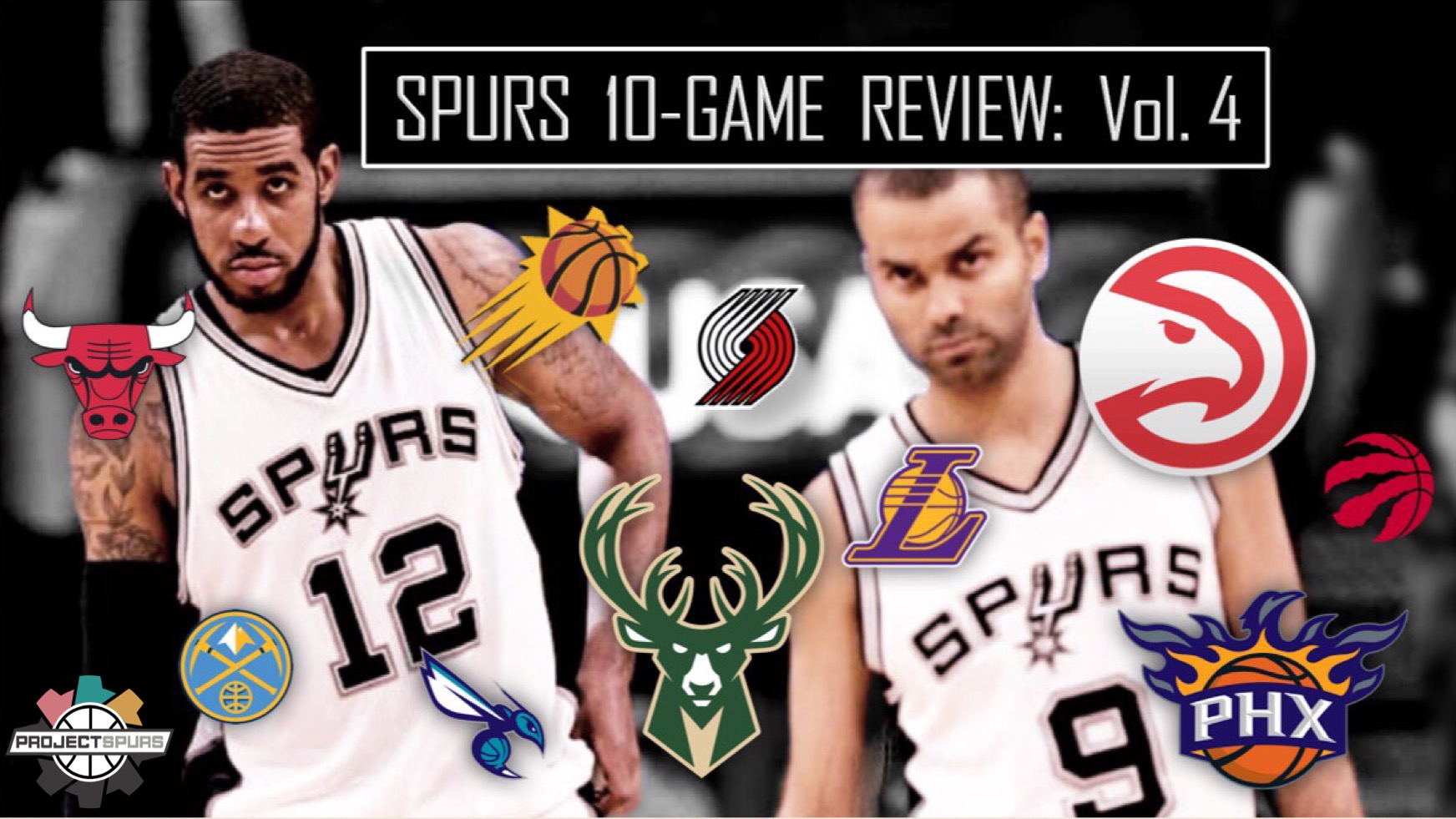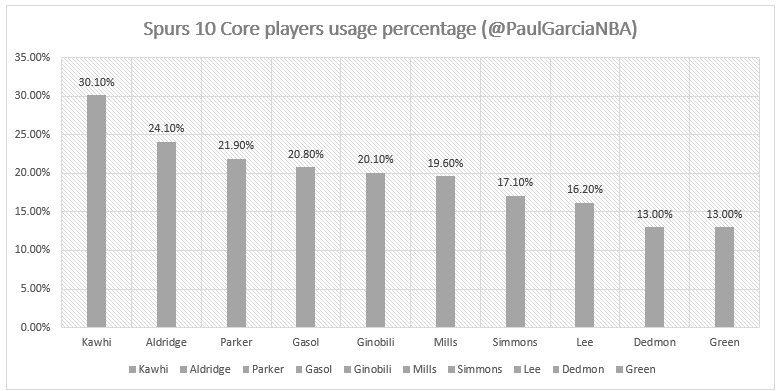With nearly half their season completed, the San Antonio Spurs remain one of the elite contenders in the NBA, as they currently sit with the second best record (31-9) after 40 games. In their last 10 games, the Spurs went 7-3, with losses coming to the Atlanta Hawks (who have won 8 of their last 10 games), and then the Milwaukee Bucks and Phoenix Suns. While three losses in 10 games isn’t ideal for the Spurs, it should be noted that they led by double digits in all three of those games, and their losses can be attributed to not putting together a complete game for 48 minutes.
As usual, let’s put the season as a whole under the statistical lens to see how the Spurs have produced either positively or negatively after 40 games.
Section I. Scoring

Offensively, the Spurs have continued to climb up the ladder in efficiency, as they’re not in the Top-5 ranking for the first time this season. A big part of why they’ve made a leap offensively is due to the raised level of play by their starting lineup. After 30 games, the Spurs’ starters consisting of Tony Parker, Danny Green, Kawhi Leonard, LaMarcus Aldridge, and Pau Gasol had played in just 15 games together, while logging 225 minutes. At that time, their Net Rating was a +4.6 Points Per 100 Possessions (Pp/100), which was good, but not spectacular.
Well, now that the starters have been given an additional seven games to play together, they’ve started to reach a new level of play, especially offensively. In 22 games and 329 minutes together, the Spurs’ starters are scoring 115.1 Pp/100 (better than the 1st ranked offense of the Toronto Raptors) and holding teams to 104.5 Pp/100 (comparable to the 9th ranked defense of the Charlotte Hornets), which now gives the Spurs’ starters a Net Rating of +10.6 Pp/100. Those numbers give the Spurs the third best lineup in the NBA overall, when looking at lineups that have logged over 300 minutes together. The only two lineups that have played more efficiently than that are the Golden State Warriors’ starting five (+21.4 Pp/100) and the Los Angeles Clippers’ starting five prior to Blake Griffin’s injury (+16.2 Pp/100).
While the Warriors are still on pace to finish with the best record in the NBA, there’s no guarantee the Clippers’ starting lineup returns to that level of efficiency when Griffin heals from his injury.
While Leonard has continued to remain the team’s go-to option and there’s no question he’ll start in the All-Star game, it’s been the turnaround play of Parker and Aldridge that have really almost given the Spurs’ starting lineup two same, but yet more efficient weapons.
In his last 10 games, Parker is averaging 15.2 points on 54% shooting and he’s collecting 5.6 assists in less than 27 minutes per game. Project Spurs’ Tom Petrini recently wrote a detailed piece about Parker’s increased productive play titled, “How Tony Parker Got His Swagger Back.” As for Aldridge, after the Spurs’ win over the Toronto Raptors on January 3, he spoke about how he’s felt more comfortable on the floor ever since the Spurs’ win in Portland on December 23, when he scored 18 points and grabbed 14 rebounds in a 20-point win.
“I would say that the Portland game was the start for it” said Aldridge. “Coach kind of force-fed me and I had the opportunity to try to find my rhythm. I had a lot of misses in that game, but I was able to find my rhythm. Ever since then, I’ve felt better.”
Since that game against Portland, there’s been a stark difference in Aldridge’s production on offense.

As that data shows, Aldridge is still getting his same number of looks and he’s getting to the free throw line at the same rate according to the two timelines. However, it’s his shooting percentage that has sky rocketed since that Portland game and with him now being an even more dangerous option from the low block and mid-range, defenses are sending more help his way, which in turn is allowing Aldridge to find his teammates more often.
In the video clip below, you can see how Aldridge has found his teammates in a few different ways. Whether it’s out of the low post, after he receives a pick and pop pass, or, he’s even attacking the rim and not settling for a jumper, which leaves his teammates open for corner threes.
[protected-iframe id=”1da9b146a3b9f24ec7b72bed0359044c-114320562-25928832″ info=”https://streamable.com/e/6k32c” style=”position:relative”]Then, there’s also the connection he and Green have developed together when he’s posting up defenders.
[protected-iframe id=”0b48b5b202e35f29ae03091091bbeadc-114320562-25928832″ info=”https://streamable.com/e/jaq6o” style=”position:relative”]As for where Aldridge likes to shoot from, his five go-to shots are the restricted area, left block, left elbow, right block, and the middle mid-range area around the free throw line. His percentages have also seen an uptick in those five areas since that game at Portland in late December.
Restricted Area: From 60.3% before playing at Portland to 66.7% afterward.
Left Block: From 39.3% before playing at Portland to 55.6% afterward.
Left Elbow Area: From 36.7% before playing at Portland to 71.4% afterward.
Right Block: From 36.4% before playing at Portland to 33.3% afterward.
Middle Mid-Range: From 43.3% before playing at Portland to 75.0% afterward.
The video below shows Aldridge’s shots from those five areas.
[protected-iframe id=”bbec879d88878fd7f40c4d2d96b32dca-114320562-25928832″ info=”https://streamable.com/e/4lzdj” style=”position:relative”]Where do the Spurs’ points come from?

The Spurs’ 3-point accuracy continues to rise compared to their opponents, as they remain the most lethal team from long range, but in terms of generating points from the outside, they still rank around league average.
Here’s an interesting stat: The Spurs have eight players who take over 1.0 threes per game. All of them (Leonard, Green, Patty Mills, Manu Ginobili, Davis Bertans, Parker, Gasol) except Jonathon Simmons shoot above league average from three so far this season. But, even Simmons is close to shooting league average (League Average = 35.8%), as he’s currently knocking down 32.7% of his 1.3 threes per game. If Simmons can get his 3-point percentage over league average by season’s end, there’s a chance he could be more sought out across the league in restricted free agency.
As written recently about the Spurs lighting up the floor from mid-range, the question of whether they need to generate more points from the 3-point area will likely come up once they get to the post-season. There’s two ways to look at the Spurs not generating enough points from the 3-point line and paint. 1) They might have one of the most balanced attacks in the NBA, where they can adapt to any type of defensive scheme. Take away their post-ups, and they’ll zip the ball all over the place to find open 3-point or mid-range range shooters, or they can go to their dribble drive attack. If your defense isn’t sound in rotations, then San Antonio can carve you up with their pick-and-roll/pop game. 2) The other side of the argument is that in today’s NBA, the two best teams that have been in the Finals the last two years have been the Cleveland Cavaliers and Warriors. Both of those teams rely heavily on getting a good chunk of their points from beyond the arc. Again, this question of whether the Spurs’ balanced offensive attack is enough will be answered in the playoffs. For now, it’s working well enough to give them a Top-5 offense.
Using the NBA’s Usage Percentages for players, I created the chart below to show the Spurs’ 10 core players and how much of the team’s possessions they’ve been using when on the floor.
The one player who seems to be slowing down a bit is Mills. Project Spurs’ own John Diaz recently wrote a piece about Mills’ season and how he’s kind of seen a decline as of late. Saturday, it should be noted that he missed the Spurs’ game against the Suns in Mexico City due to tightness in his left calf. Though Green doesn’t take up a majority of the team’s possessions, I recently wrote about how he’s back to being a dangerous weapon from the outside for San Antonio anytime Parker, Leonard or Aldridge draw in his defender. Green’s even shown a little bit more progression in putting the ball on the floor from time to time and dropping passes off in the right place at the right time.
Where do the Spurs rank in Offense thus far?
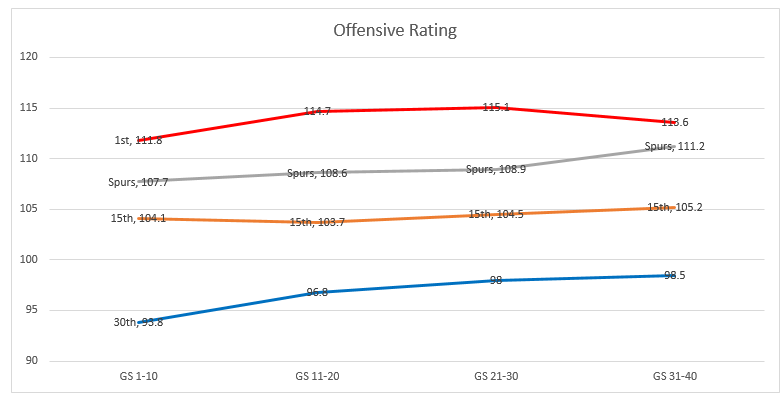
Best: Toronto Raptors 113.6 PP/100
Spurs: 111.2 PP/100 – 4th
League Average: Oklahoma City Thunder 105.4 PP/100
Worst: Philadelphia 76ers 98.5 PP/100
Though the Raptors and Warriors have exchanged spots as the best offensive teams in the league at different times this season, the Spurs are close to knocking on the door of being the best offense, as they’re now within two points per 100 possessions of matching Golden State and Toronto.
Section II. Ball Movement

With Leonard, Aldridge and Parker back in place of being the Spurs’ top-3 playmakers, the team has seen a small increase in secondary assists. When those three players receive help from the defense, they usually swing it once, then the receiving player passes once more for the next player to usually get a 3-pointer or shot at the rim. Meaning, when thinking about ‘good to great’ shots, the Spurs are right there behind the Warriors and Houston Rockets in getting those types of points.Though it’s not quite consistent because the majority of the Spurs’ possessions are run though Leonard and Aldridge, they have shown that they can move the ball all over the place in certain games, as they’ve already had eight games where they’ve collected 30 or more assists. The common factor when the Spurs do get those 30 assist nights – it’s usually against some of the bottom 10 defensive teams in the league.
Section III. Defense
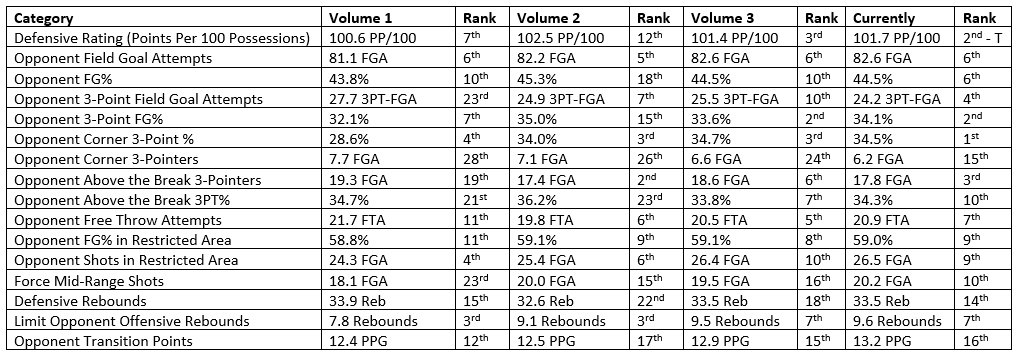
In today’s high scoring NBA, where the average team is scoring 105.0 points per game, the Spurs have remained elite defensively, as they’ve held 30 of their 40 opponents below 105 points so far this season.While the Spurs are currently second in defense, there were a few nights over the last 10 games when they were the best defensive team in the league. Right now, on a night to night basis, San Antonio, Memphis, Utah and Golden State are all shifting 1-4 defensively. If you had to pick two areas where the Spurs have really improved defensively, it’s in their 3-point defense of limiting opponent shots from beyond the arc, and they’re now forcing teams to take the shot most teams don’t value these days – the mid-range look.
Defensively, the Spurs’ lock down quarter is usually the third quarter, where they’re holding teams to 96.8 PP/100 in those 12 minutes. However, when the Spurs don’t put together a full 48-minute game, and especially when they don’t adjust to the opposing offense after halftime, the chances of a loss are usually more in sight.
In their three most recent losses, the Spurs didn’t make the adjustment after halftime defensively and those teams scored 25 or more points in each third quarter. The result was those teams all scoring over 105 points overall in those games and the Spurs ending up with a loss.
Hawks: 25 points in third quarter, by the end of the game, 114 points.
Bucks: 30 points in third quarter, by the end of the game, 109 points.
Suns: 29 points in third quarter, by the end of the game, 108 points.
Not making the defensive adjustment or focusing after halftime was something Spurs Head Coach Gregg Popovich discussed after the Spurs’ loss to the Bucks.
“The problem is we didn’t guard real well,” said Popovich that evening. “Obviously, (Michael) Beasley was great – we never stopped him. In general, our defense was not up to par. They took advantage of it and they did a great job offensively. We talked the whole second half that if we keep letting them score like that, we’re going to have a big problem. It’s going to come down to who makes a shot at the end and that can always go either way. I’m disappointed in our defense.”
For the majority of their games, the Spurs are getting more physical and locking in defensively after halftime, but on those nights when they don’t put together a full 48-minute game plan, the trend has been a high scoring game and loss.
Where do the Spurs rank in Defense thus far?
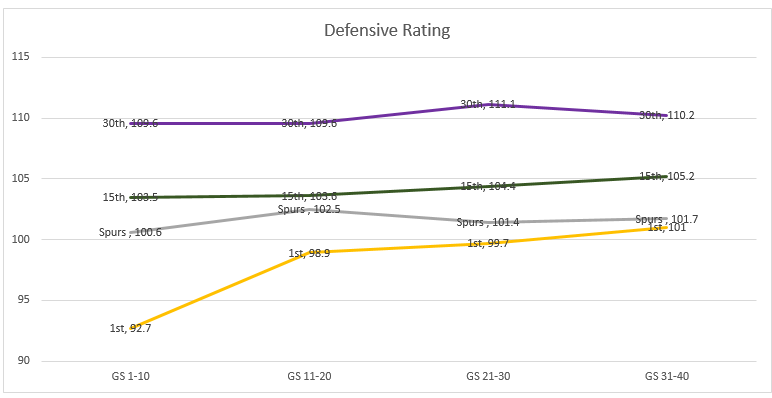
Best: Utah Jazz 101.0 PP/100
Spurs: 101.7 PP/100 – Tied for 2nd with Golden State
League Average: Milwaukee Bucks 105.2 PP/100
Worst: Los Angeles Lakers 110.2 PP/100
Section IV. Record Vs. Elite teams (.600 Winning Percentage)
| Category | Currently |
| Winning Percentage | 64% |
| Record | 7-4 |
The Spurs are currently 7-4 against teams with records of .600 or above.
Golden State Warriors: 1-0
Los Angeles Clippers: 0-2
Houston Rockets: 2-1
Toronto Raptors: 1-0
Boston Celtics: 2-0
Utah Jazz: 1-1
Total: 7-4
Section V. The Next 10
The Spurs’ next 10 games will take place over 19 days from 01/17 to 02/04. During that stretch, the team will play six home games and four games on the road. The Spurs will only have to play one back-to-back during that time span and of teams with records above .600, they’ll see Cleveland for the first time and then meet Toronto once more, but this time in the Raptors’ home building.
Data gathered from NBA.com/stats. Bench stats collected from HoopsStats.com after 39 games for San Antonio.
You can also check out Volume 1, Volume 2, and Volume 3.
Add The Sports Daily to your Google News Feed!
